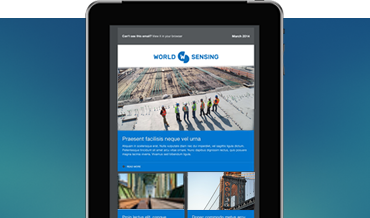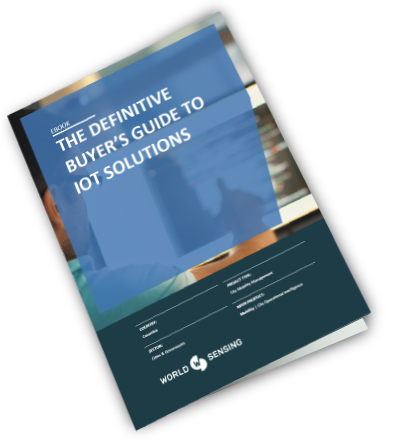7 pain points and 7 of our solutions for customers using IoT networks
Sensor networks are wondrous things, allowing companies and public authorities to gain valuable insights from the world around us. But even as these networks spread—Worldsensing alone monitors mobility in several cities and controls the integrity of 100’s infrastructures, for example—there are a set of common challenges that Internet of Things (IoT) customers come up against time and again.
Fortunately, we’ve been in the business long enough to have solved these challenges. While it is our vision to digitize data collection in traditional industries such as mining and construction, we are already empowering engineers across more than 70 countries to automate data readings to collect information remotely. Here are seven of the most frequent issues—and what we can do to overcome them.
1. It costs a lot to collect data
Even though it’s 2020, a surprising number of companies still collect data manually. This is costly and, in some environments, can even be dangerous. Readings can only be taken when someone goes out to the site. To get over this problem, you can fit data loggers to the sensors and wire them up to a network. But cabling can be vulnerable to damage. And laying cables is a costly affair if monitoring points are spread over large areas and working environments constantly change.
Our solution: We provide wireless data acquisition systems that enable real-time monitoring of geotechnical and structural sensors.
2. Industrial working sites are harsh environments
A frequent problem with industrial IoT deployments is that the working sites are harsh environments extending over large areas, and sensors tend to be located in places that are not easy to reach. As a result, fitting a data logger to each sensor is costly. Sometimes the cost of installation is more than the data node itself, and having many different solutions does not help standardize installation and maintenance procedures.
Our solution: Our data nodes are used to digitize a variety of structural and geotechnical sensors and can last up to a decade without needing to be replaced, so once you have installed them the recurring cost will be minimal. They are quick and easy to set up via mobile application which also facilitates installation procedures. On top of that, the nodes are designed for resiliency, IP67 certified and tested to sustain from -40ºC to +80ºC under any weather conditions. This makes our solution one of the most resilient and rugged on the market.
3. Investment in traditional industry sensors has to be protected
Most industrial companies rely on a perfectly good sensor network, which has proven reliable and effective over the years. These sensors still provide great readings and are the best way to extract underground data. It is understandable that Industrial companies are willing to maintain their long-term investments and make sure any evolution in their data pipelines includes traditional sensors as a key asset.
Our solution: Our nodes connect, integrate and operate with the main players in the industry, including analog and digital sensor types and makes. Having one solution provider able to plug into all the traditional sensors helps our customers avoid having a fragmented technological value chain, making it easier for IT teams to run their operations and standardize procedures once they have decided to move to remote infrastructure monitoring.
4. It’s difficult finding experts who can install sensor networks in remote areas
If you are trying to monitor a mine in the jungle, then finding reliable partners who can set up a monitoring system can be a challenge. Industrial IoT networks rely on very specific expertise, which includes low-power wide-area networks (LPWAN) knowledge. This skillset is very scarce in the market and having reliable connectivity can be compromised if the partner can’t deliver.
Our solution: Our expertise in more than 10 years of providing remote data acquisition, networking, and gateway equipment has proved very valuable to our customers. Our capacity to provide global service through a well-trained network of engineering service providers in over 60 countries provides huge peace of mind to governments and companies and makes sure their move to data automation is safe and sound.
5. Compliance is adding to the monitoring burden
Recent incidents around tailings dams have added to the compliance burden for companies mining. As well as being able to respond to incidents quickly, companies need to demonstrate that they are monitoring infrastructural assets in real-time.
Our solution: Worldsensing not only offers systems that can deliver automated alerts on anomalous readings, to make sure companies never miss worrying data points, but also provides a backup solution to store all the data safely over time. To comply with government requirements, companies need to inform about these data events in a timely way, and we provide different mechanisms to make sure our customers can schedule their reports to be sent to the relevant authorities on time and with the detail needed remotely.
6. Adding new equipment will make a mess of the network
If you only have one or two vendors, then it’s easy to fit them onto a single network. As the number of technology vendors increases, so does the chance that companies will be saddled with different network infrastructures, making it harder for IT teams to operate and monitor services over time.
Our solution: Worldsensing’s technology stack has been built using open standards and best IT practices to ensure we provide third-party integration capabilities into our networking offering. This way our customers can select the best vendors based on features and rely on our network monitoring capabilities to make sure deployment and integration between systems is operating as expected, based on IT department procedures.
7. Distributing data to different analysis packages can be a chore
Getting information from your sensor networks is one thing but distributing it to different systems for analysis is quite another. A geotechnical model will not speak the same language as an enterprise resource planning package, for instance.
Our solution: We have built our software applications using the same level of openness as in our networking strategy. Our customers can rely on us to provide integration with pretty much all industry protocols. So, once your data is safely stored and centralized it can be shared wherever and whenever you want.
This is key to making sure data can safely circulate and follow our partners’ networking and application standards.


